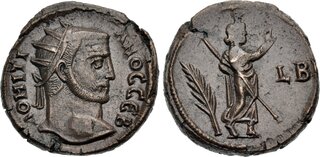| Classical Numismatic Group > Triton XXVII | Auction date: 9 January 2024 |
| Lot number: 558 Price realized: 1,750 USD (Approx. 1,603 EUR) Note: Prices do not include buyer's fees. | Show similar lots on CoinArchives Find similar lots in upcoming auctions on |
| Lot description: EGYPT, Alexandria. Domitius Domitianus. Usurper, AD 297-298. Potin Octodrachm(?) (22mm, 8.52 g, 11h). Dated RY 2 (AD 297/8). ΔOMITI ANOC CЄB, radiate head right / Serapis standing right, raising right hand, holding scepter with left, palm frond to left; L B (date) across field. Köln 3367 var. (position of date); Dattari (Savio) 10829-32; K&G 126.2; RPC X Online 76424; Emmett 4241.2. Brown patina, slight reverse weakness, light roughness, small flan crack. Good VF. Rare. From the Dr. Thomas E. Beniak Collection. Ex Classical Numismatic Auctions V (9 December 1988), lot 210; Numismatic Fine Arts XII (23 March 1983), lot 441. The revolt of Domitius Domitianus in Egypt destabilized a vitally strategic region by interrupting the grain supply to Rome and opening the possibility of a Sasanian invasion. For almost a year, Domitius Domitianus controlled Alexandria and its mint, striking aurei and folles, as well as a series of pre-reform provincial denominations. Domitianus issued a denomination reform at Alexandria during his brief occupation of the city. A major question regarding these latter coins has been what were their specific values. For the most part, scholars agree that the larger coins featuring the radiate bust must be a double, and thereby call it an octodrachm. At half the weight, then, the smallest coins with the Nike on the reverse must be tetradrachms, though these coins have erroneously been called heretofore didrachms. The weights of these tetradrachms appear consistent with the final issues of pre-reform tetradrachms of the Tetrarchs. The middle denomination poses the largest challenge to this arrangement. By weight, it should be a hexadrachm. However, no such denomination was known to have been struck in Egypt, though tetradrachms earlier in the third century achieved this weight. The obvious problem here would be the confusion caused in circulating the same denomination in two different weights. As this type is the rarest of the group, it is possible that it was meant for a special occasion, or more remotely, a stalled attempt to reinstitute the pre-reform coinage on an earlier weight standard. Further investigation may shed more light on this subject. Estimate: 2000 USD |  |



